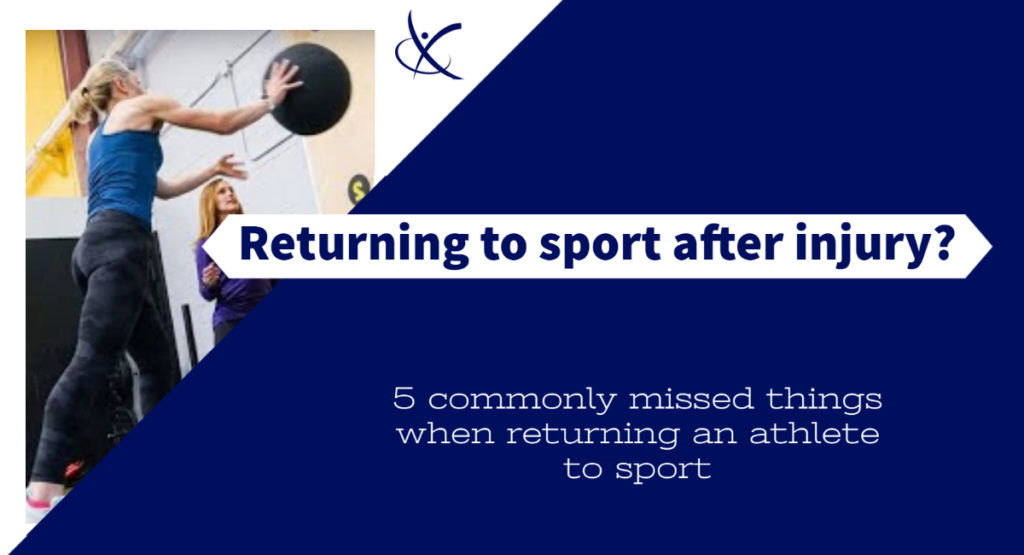Return to Sport Decision Making
A Physical Therapist’s Thoughts on Returning to Activity After Injury
A few weeks ago, this topic popped into my head after a frustrating conversation.
By no fault of their own, a parent looked at me and said, “Thanks for working with him but the doctor cleared him, so he will be playing this weekend.”
I was ready to blow a gasket.
Before this, I spent ample time educating. I discussed the importance of a gradual re-entry to sport and the likelihood of re-injury. I discussed muscle capacity & loads and how returning to play at 100% too soon could be detrimental. The unfortunate part… my words went right out the window as soon as another provider said, “you can play again.”
Shortly after this athlete returned to play, they returned to the sidelines. It was a major bummer, especially because I knew he/she was not ready.
The decision-making process when allowing an athlete to return to sport is multifactorial. So, here are five important things that are often forgotten during the process.
1. Pain does not dictate function.
Having no or minimal pain does not mean that you are ready to return to play. Also, having some pain doesn’t always mean that you cannot play. Pain is not always a good measure of an athlete’s ability to return to the field. For example, you may go into an office where a provider performs a hands-on assessment of your pain and strength. One of the biggest issues with this, is that these hands-on assessments do not correlate to the power and energy an athlete may use during sport. It also does not take into consideration their performance when fatigued. Your muscles need to have the capacity to do what you’re asking of them. Pain-free does not always mean they’ve regained the full strength and power needed to get back to sport.
2. Importance of a true return to sport assessment.
For all athletes (runners, swimmers, field sports, etc.) a return to sport assessment is imperative after injury. With my athletes, I always perform a movement-based return to sport testing protocol. This looks at their: range of motion, power production, strength, motor control and coordination, endurance, and more. I do not solely rely on my hands-on strength/pain assessments. I make sure that the athlete is well prepared to return to sport to decrease the risk of re-injury. If you are an athlete returning from injury and have not received through a return to sport series of testing, find someone who can help! Not only will this find your potential weak links in sport, but it will also help with a successful return to performance.
3. Generalized health and psychological wellness screenings.
Being in good physical and mental health is imperative for athletes. Injury often leads to identity crises in athletes. It may also trigger things such as disordered eating and energy deficiency. Being too confident or fearful of returning to sport is also an indicator that an athlete is not ready. Generalized health and psychological wellness are often overlooked. Making sure an athlete receives a full physical and sports-psychologist before returning to sport is imperative. Athletes need to be physically and mentally healthy prior to returning to activity or else the risk for injury increases!
4. Communication between providers.
Communication is key when returning an athlete to sport. The decision of returning an athlete back to sport is multifactorial. It not only has to do with post-operative or post-injury healing but physical and psychological readiness. Also, every rehabilitation case will be different! Providers including physical therapists, physicians, psychologists, sports-performance coaches, etc., should be in contact. Returning an athlete to sport should be a multi-disciplinary decision. It should not simply be based on healing timelines or simple manual muscle tests. It requires physical readiness assessments, psychological wellness assessments, and more! It should be a team effort.
5. Return to play versus return to performance.
If someone tells you that you are ready to play, it does not always mean you are ready to perform. Returning to play(or sport) after injury is your re-entry phase. This means there will be a gradual return to activity with guidelines and supervision. During return to play activity, there will be building blocks. You cannot simply return to 100% normal function. This is often where athletes, coaches, and medical staff fail athletes. Return to play does not equal return to performance. Return to performance is when your return to play protocol is complete and you pass a return to sport assessment with flying colors. Until then, remember to take it easy and look for help/guidance when needed. Remember, slow and steady wins the race.
Alright, folks, this may not be rocket science, but I hope it helps. Returning to sport is not as easy as getting clearance from one provider. It’s about assessing an athlete for health and psychological wellness, communication amongst providers, and a proper return to sport plan.
If you have any questions about any of this information, don’t hesitate to ask.
Yours in health,
Ashley
